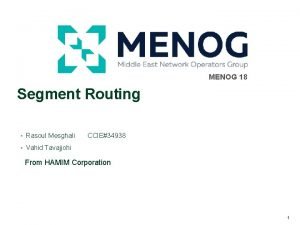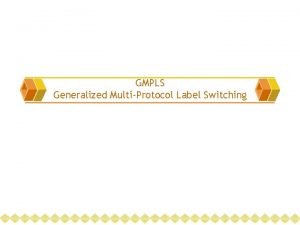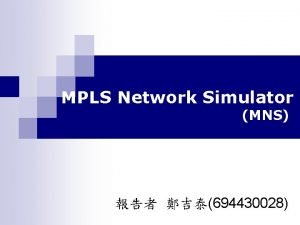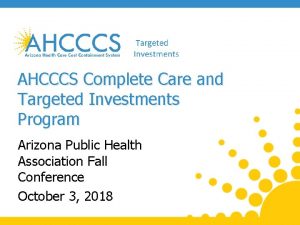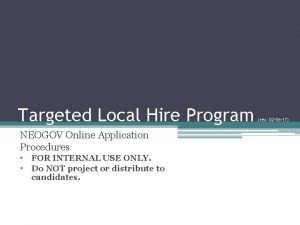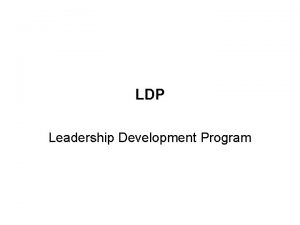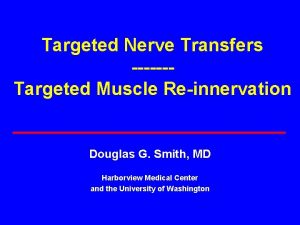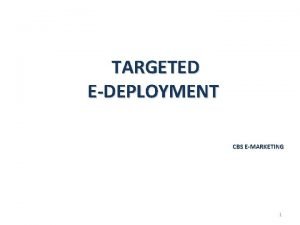draftietfmplsappawaretldp01 Applicationaware Targeted LDP draftietfmplsappawaretldp01 Raveendra Torvi rtorvijuniper







- Slides: 7

draft-ietf-mpls-app-aware-tldp-01 Application-aware Targeted LDP draft-ietf-mpls-app-aware-tldp-01 Raveendra Torvi (rtorvi@juniper. net) Luay Jalil (luay. jalil@verizon. com) Kamran Raza (skraza@cisco. com) Zhenbin Li (lizhenbin@huawei. com) Uma Chunduri (uma. chunduri@ericsson. com) Chris Bowers (cbowers@juniper. net) Santosh Esale (sesale@juniper. net) IETF-94 (Yokohama) Speaker: Santosh Esale

draft-ietf-mpls-app-aware-tldp-01 Central Idea • Initiating and responding LSR are made aware of targeted LDP application that needs a t. LDP session • Benefits • Establishment of automatic t. LDP session based on negotiated targeted LDP applications • Establishment of limited number of t. LDP sessions for certain automatic applications • Targeted application mapped to LDP FEC elements to advertise only necessary FEC label bindings over the session

draft-ietf-mpls-app-aware-tldp-01 Protocol changes • Advertise and negotiate targeted applications capability (TAC) during t. LDP session initialization • The TAC TLVs capability data consists of one or more targeted application element (TAE) each pertaining to unique targeted application • On the receipt of a valid TAC TLV, an LSR must generate its own TAC TLV with TAEs • If there is at least one TAE common between the TAC TLV it has received and its own, the t. LDP session proceed to establishment as per RFC 5036. If not, a LSR sends a ‘Session Rejected/Targeted Application Capability Mis-Match’ message to the peer and close the session

draft-ietf-mpls-app-aware-tldp-01 New since last update Targeted application FEC advertisement procedures Targeted Application Description FEC type mappings LDPv 4 Remote LFA LDPv 4 over LDPv 4 or other MPLS tunnel IPv 4 prefix LDPv 6 Remote LFA LDPv 6 over LDPv 6 or other MPLS tunnel IPv 6 prefix LDP FEC 129 PW m. LDP Node Protection Or m. LDP Tunneling LDP FEC 128 PW etc LDP FEC 129 Pseudowire Generalized Pwid FEC Element m. LDP nodeprotection P 2 MP, MP 2 MP-up MP 2 MP-down HSMPdownstream HSMP-upstream LDP FEC 128 P seudowire PWid FEC Element . .

draft-ietf-mpls-app-aware-tldp-01 New since last update • Interaction of targeted application capabilities and state advertisement control capabilities • TAC • Facilitates the awareness of targeted applications to both the peers • The set of applications negotiated by the TAC mechanism is symmetric between the two LDP peers • SAC • Responding LSR is not aware of targeted applications • Creates asymmetric advertisement of state information between the two peers. • Thus the TAC mechanism enables two LDP peers to symmetrically advertise state information for negotiated targeted applications while SAC mechanism enables both of them to asymmetrically disable receipt of state information for some of the already negotiated applications

draft-ietf-mpls-app-aware-tldp-01 Use cases • Remote LFA • FEC 129 • LDP over RSVP tunneling • m. LDP node protection

draft-ietf-mpls-app-aware-tldp-01 Next steps • Summary • Latest version addresses all the comments that • that we have received so far • Of course, more comments are always welcome • Draft addresses real deployment use-cases • The authors believe that the draft is ready for WGLC
